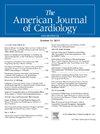Arteriosclerotic Calcification and Atrial Fibrillation in the General Population: The Rotterdam Study
IF 2.3
3区 医学
Q2 CARDIAC & CARDIOVASCULAR SYSTEMS
引用次数: 0
Abstract
Limited population-based data on the gender differences and association between arteriosclerotic calcification at different sites and atrial fibrillation (AF) exist. We aimed to investigate the (gender-specific) associations between arteriosclerotic calcification at different sites with the risk of AF in the general population. Arteriosclerotic calcification was quantified using computed tomography examinations between 2003 and 2006 in 2,259 participants free of AF from the population-based Rotterdam Study. Cox proportional hazards models, adjusted for cardiovascular risk factors, were used to assess the associations of volumes of coronary artery calcification (CAC), aortic arch calcification (AAC), extracranial and intracranial carotid arteries, vertebrobasilar arteries, and the aortic valve with incident AF. During a median follow-up of 8.6 years, 182 incident AF cases occurred. A larger CAC was associated with incident AF (hazard ratio [HR], 95% confidence interval [CI] 1.25 1.09 to 1.44, p = 0.0019). The gender-stratified analyses showed that larger CAC in men (HR 1.43, 95% CI 1.10 to 1.86, p = 0.0068) and larger AAC in women were associated with incident AF (HR1.44, 95% CI 1.04 to 2.01, p = 0.0299). In conclusion, CAC in the general population, especially in men, and AAC in women were significantly associated with new-onset AF. Our findings imply that interventions to lower arteriosclerotic calcification, particularly, CAC, carry potential for the prevention of AF in the general population, especially in men.
普通人群中的动脉硬化钙化和心房颤动:鹿特丹研究。
背景:关于不同部位动脉硬化钙化与心房颤动(房颤)之间的性别差异和关联的人群数据有限。我们旨在调查不同部位的动脉硬化钙化与普通人群房颤风险之间的(性别特异性)关联:方法:2003-2006年间,我们对鹿特丹人群研究中2259名无房颤的参与者进行了CT检查,对动脉硬化钙化进行了量化。在对心血管风险因素进行调整后,采用 Cox 比例危险模型评估冠状动脉钙化(CAC)、主动脉弓钙化(AAC)、颅内外颈动脉、椎基底动脉和主动脉瓣的体积与房颤事件的关联:在中位随访 8.6 年期间,共发生 182 例房颤事件。较大的 CAC 与房颤事件相关(危险比 (HR),95% CI,1.25, 1.09-1.44, p=0.0019)。性别分层分析显示,男性较大的CAC(HR,95% CI,1.43,1.10-1.86,p=0.0068)和女性较大的AAC与房颤事件有关(HR,95% CI,1.44,1.04-2.01,p=0.0299):结论:普通人群(尤其是男性)中的 CAC 和女性中的 AAC 与新发房颤密切相关。我们的研究结果表明,降低动脉硬化钙化(尤其是 CAC)的干预措施具有在普通人群(尤其是男性)中预防房颤的潜力。
本文章由计算机程序翻译,如有差异,请以英文原文为准。
求助全文
约1分钟内获得全文
求助全文
来源期刊

American Journal of Cardiology
医学-心血管系统
CiteScore
4.00
自引率
3.60%
发文量
698
审稿时长
33 days
期刊介绍:
Published 24 times a year, The American Journal of Cardiology® is an independent journal designed for cardiovascular disease specialists and internists with a subspecialty in cardiology throughout the world. AJC is an independent, scientific, peer-reviewed journal of original articles that focus on the practical, clinical approach to the diagnosis and treatment of cardiovascular disease. AJC has one of the fastest acceptance to publication times in Cardiology. Features report on systemic hypertension, methodology, drugs, pacing, arrhythmia, preventive cardiology, congestive heart failure, valvular heart disease, congenital heart disease, and cardiomyopathy. Also included are editorials, readers'' comments, and symposia.
 求助内容:
求助内容: 应助结果提醒方式:
应助结果提醒方式:


